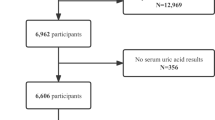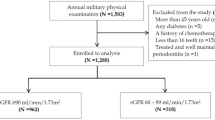Abstract
Background
Our previous pilot study using patients with type 2 diabetes mellitus in one medical clinic showed an association of urinary albumin excretion, a marker of generalized vascular dysfunction and kidney damage, with periodontitis. The purpose of this study was to confirm the association by increasing the number of patients and medical clinics.
Methods
Participants were 2302 patients (59.9% males, aged 29–93 years) with type 2 diabetes mellitus from 25 medical clinics. Their medical records and information about socioeconomic status and health behavior were collected. Periodontal status was assessed in a nearby dental office. Multiple linear regression analyses were conducted to examine the association of log-transformed urinary albumin-to-creatinine ratio with periodontal parameters after adjusting for sociodemographic status, general health conditions, and health behaviors. The analyses were performed in all subjects and subjects with normoalbuminuria only.
Results
Multiple linear regression analysis showed that mean probing pocket depth (beta: 0.062), percentage of sites with probing pocket depth of 4 mm or deeper (beta: 0.068), percentage of mobile teeth (beta: 0.055), and severity of periodontitis (beta: 0.049) were significantly (p < 0.05) correlated with log-transformed urinary albumin-to-creatinine ratio after adjusting for possible confounders in all subjects. However, no significant associations between urinary albumin-to-creatinine ratio and periodontal parameters were observed in subjects with normoalbuminuria only.
Conclusions
These results suggest that periodontitis is associated with urinary albumin excretion in patients with type 2 diabetes mellitus. Collaboration between medical and dental healthcare providers is needed for treatment of diabetes and periodontitis.
Similar content being viewed by others
References
Whiting DR, Guariguata L, Weil C, et al. IDF diabetes atlas: global estimates of the prevalence of diabetes for 2011 and 2030. Diabetes Res Clin Pract. 2011;3:311–21.
Chan JC, Malik V, Jia W, et al. Diabetes in Asia: epidemiology, risk factors, and pathophysiology. JAMA. 2009;20:2129–40.
Ali MK, Bullard KM, Saaddine JB, et al. Achievement of goals in US diabetes care, 1999–2010. N Engl J Med. 2013;17:1613–24.
Yokoyama H, Araki SI, Kawai K, et al. Declining trends of diabetic nephropathy, retinopathy and neuropathy with improving diabetes care indicators in Japanese patients with type 2 and type 1 diabetes (JDDM 46). BMJ Open Diabetes Res Care. 2018;1:e000521.
Remuzzi G, Schieppati A, Ruggenenti P. Clinical practice. Nephropathy in patients with type 2 diabetes. N Engl J Med. 2002;15:1145–51.
Iwasaki M, Taylor GW, Nesse W, et al. Periodontal disease and decreased kidney function in Japanese elderly. Am J Kidney Dis. 2012;2:202–9.
Saremi A, Nelson RG, Tulloch-Reid M, et al. Periodontal disease and mortality in type 2 diabetes. Diabetes Care. 2005;1:27–32.
Sharma P, Dietrich T, Ferro CJ, et al. Association between periodontitis and mortality in stages 3–5 chronic kidney disease: NHANES III and linked mortality study. J Clin Periodontol. 2016;2:104–13.
Fisher MA, Taylor GW, West BT, et al. Bidirectional relationship between chronic kidney and periodontal disease: a study using structural equation modeling. Kidney Int. 2011;3:347–55.
Tsioufis C, Thomopoulos C, Soldatos N, et al. Periodontal disease severity and urinary albumin excretion in middle-aged hypertensive patients. Am J Cardiol. 2011;1:52–8.
Salimi S, Ng N, Seliger SL, et al. Periodontal disease, renal dysfunction and heightened leukocytosis. Nephron Clin Pract. 2014;1–2:107–14.
Kang SH, Park JW, Cho KH, et al. Association between periodontitis and low-grade albuminuria in non-diabetic adults. Kidney Blood Press Res. 2017;2:338–46.
Kuroe A, Taniguchi A, Sekiguchi A, et al. Prevalence of periodontal bacterial infection in non-obese Japanese type 2 diabetic patients: relationship with C-reactive protein and albuminuria. Horm Metab Res. 2004;2:116–8.
Han K, Nam GE, Kim DH, et al. Association of periodontitis with urinary albumin excretion in Korean adults with diabetes: the 2012 Korea national health and nutrition examination survey. Medicine (Baltimore). 2015;42:e1839.
Yokoyama H, Yamamoto T, Tanaka M, et al. Albuminuria, C-reactive protein, and socioeconomic factors are associated with periodontal status in subjects with type 2 diabetes. Diabetology International. 2019;10:250–9.
Madianos PN, Koromantzos PA. An update of the evidence on the potential impact of periodontal therapy on diabetes outcomes. J Clin Periodontol. 2018;2:188–95.
Feldt-Rasmussen B. Microalbuminuria, endothelial dysfunction and cardiovascular risk. Diabetes Metab. 2000;26(Supple 4):64–6.
Gerstein HC, Mann JF, Yi Q, et al. Albuminuria and risk of cardiovascular events, death, and heart failure in diabetic and nondiabetic individuals. JAMA. 2001;4:421–6.
Brantsma AH, Bakker SJ, de Zeeuw D, et al. Urinary albumin excretion as a predictor of the development of hypertension in the general population. J Am Soc Nephrol. 2006;2:331–5.
Fox CS, Matsushita K, Woodward M, et al. Associations of kidney disease measures with mortality and end-stage renal disease in individuals with and without diabetes: a meta-analysis. The Lancet. 2012;9854:1662–73.
Murussi M, Campagnolo N, Beck MO, et al. High-normal levels of albuminuria predict the development of micro- and macroalbuminuria and increased mortality in Brazilian Type 2 diabetic patients: an 8-year follow-up study. Diabet Med. 2007;10:1136–42.
Haneda M, Noda M, Origasa H, et al. Japanese clinical practice guideline for diabetes 2016. J Diabetes Investig. 2018;9:657–97.
Lang NP, Adler R, Joss A, et al. Absence of bleeding on probing. An indicator of periodontal stability. J Clin Periodontol. 1990;10:714–21.
Miller SC. Textbook of Periodontia. Philadelphia: Blakiston Co; 1950.
Tonetti MS, Greenwell H, Kornman KS. Staging and grading of periodontitis: framework and proposal of a new classification and case definition. J Clin Periodontol. 2018;45(Suppl 20):S149–61.
Kingman A, Albandar JM. Methodological aspects of epidemiological studies of periodontal diseases. Periodontol. 2000;2002:11–30.
Martins D, Tareen N, Zadshir A, et al. The association of poverty with the prevalence of albuminuria: data from the Third National Health and Nutrition Examination Survey (NHANES III). Am J Kidney Dis. 2006;6:965–71.
Fraser SD, Roderick PJ, Aitken G, et al. Chronic kidney disease, albuminuria and socioeconomic status in the Health Surveys for England 2009 and 2010. J Public Health (Oxf). 2014;4:577–86.
Boillot A, El Halabi B, Batty GD, et al. Education as a predictor of chronic periodontitis: a systematic review with meta-analysis population-based studies. PLoS One. 2011;7:e21508.
Schuch HS, Peres KG, Singh A, et al. Socioeconomic position during life and periodontitis in adulthood: a systematic review. Commun Dent Oral Epidemiol. 2017;3:201–8.
Ministry of Health LaW. Survey of dental diseases; 2016. https://www.mhlw.go.jp/toukei/list/62-17.html. Accessed 1 Aug 2019.
Nelson RG, Shlossman M, Budding LM, et al. Periodontal disease and NIDDM in Pima Indians. Diabetes Care. 1990;8:836–40.
Khader YS. Factors associated with periodontal diseases in Jordan: principal component and factor analysis approach. J Oral Sci. 2006;2:77–84.
Schenkein HA, Loos BG. Inflammatory mechanisms linking periodontal diseases to cardiovascular diseases. J Clin Periodontol. 2013;40:S51–69.
Tonetti MS, D’Aiuto F, Nibali L, et al. Treatment of periodontitis and endothelial function. N Engl J Med. 2007;9:911–20.
Acknowledgements
The authors thank Mr. Suguho Takahashi and Ms. Miki Sato (Jiyugaoka Medical Clinic, Obihiro, Japan) for their skillful data collection and management of the research office. The authors also thank members of the Japan Clinicians Diabetes Association (Drs. Koichi Kawai, Hiroshi Takamura, Masato Takaki, Daigaku Uchida, Akiko Hosokawa, Jokichi Suzuki, Koichi Iwasaki, Hideo Ayame, Noriharu Yagi, Mitsutoshi Kato, Yoshifumi Yokomizo, Mitsue Fujita, Hitoshi Minowa, Hikaru Amemiya, Masae Minami, Kazuhiko Takahashi, Hiroaki Horie, Shigeki Yamamoto, and Yasuo Yamana) for their contribution to data collection of medical parameters. The authors also thank participating dentists for their contribution to collection of periodontal health parameters. This study was supported in part by the 8020 Research Grant for fiscal 2018 from the 8020 Promotion Foundation (adopted no. 18-6-16). The funder had no role in the design of the study and collection, analysis, and interpretation of data or in writing the manuscript.
Author information
Authors and Affiliations
Contributions
Michio Tanaka and Tatsuo Yamamoto conceived the idea for the study, participated in its design, performed the statistical analysis, and drafted the manuscript. Fuminobu Okuguchi, Haruhiko Isotani, Masahiro Iwamoto, Hidekatsu Sugimoto, Osamu Nakagawa, Daisuke Suzuki, Katsushige Abe and Nobuaki Watanabe participated in data acquisition and critically revised the manuscript. Nobuichi Kuribayashi and Hiroki Yokoyama helped develop the idea for the study, participated in data acquisition and study design, and edited the manuscript. Masato Minabe and Sinya Fuchida helped develop the idea for the study and critically revised the manuscript. All authors read and approved the final manuscript.
Corresponding author
Ethics declarations
Conflict of interests
Kuribayashi received lecture fees from Mitsubishi Tanabe Pharma Corp. All other authors declare that they have no conflict of interest.
Research involving human participants
The study protocol was approved by the ethics committees of Jiyugaoka Medical Clinic (October 27, 2014, No. 250716) and Kanagawa Dental University July 5, 2016, No. 387; September 12, 2017, No. 446; December 20, 2017, No. 476). All procedures followed were in accordance with the ethical standards of the responsible committee on human experimentation (institutional and national) and/or with the Helsinki Declaration of 1964 and later versions. Informed consent or substitute for it was obtained from all patients for being included in the study.
Additional information
Publisher's Note
Springer Nature remains neutral with regard to jurisdictional claims in published maps and institutional affiliations.
About this article
Cite this article
Tanaka, M., Yamamoto, T., Kuribayashi, N. et al. Association of urinary albumin excretion with periodontal parameters in patients with type 2 diabetes mellitus: a cross-sectional study. Diabetol Int 11, 121–128 (2020). https://doi.org/10.1007/s13340-019-00413-w
Received:
Accepted:
Published:
Issue Date:
DOI: https://doi.org/10.1007/s13340-019-00413-w




